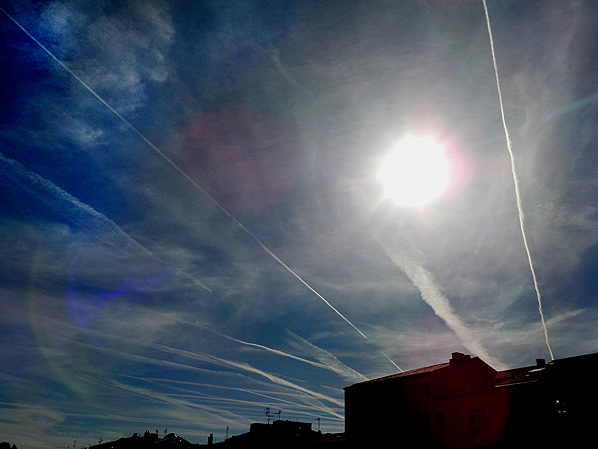Search
Recent comments
- more polling....
51 min 23 sec ago - they know....
3 hours 41 min ago - past readings....
4 hours 41 min ago - jihadist bob.....
4 hours 47 min ago - macronicon.....
6 hours 41 min ago - fascist liberals....
6 hours 42 min ago - china
10 hours 17 min ago - google bias...
1 day 3 hours ago - other games....
1 day 3 hours ago - נקמה (revenge)....
1 day 4 hours ago
Democracy Links
Member's Off-site Blogs
no clouds but thin water vapour trails...

Climate models may be underestimating how sensitive the planet is to rising greenhouse gas levels, with new research suggesting the pace of global warming is about to quicken.
Scientists have long known that adding carbon dioxide to the atmosphere warms the globe. The so-called greenhouse gas effect, though, may be amplified the higher the mercury climbs, according to a study published recently in Science Advances.
Read more:
http://www.smh.com.au/environment/climate-change/warming-up-new-research...
Picture at top: "Chemtrails" over Europe. Chemtrails are mostly condensed water vapour that form clouds. Most of the rest of the trails we cannot see is CO2. Without planes going over this region, there would only be a blue sky, no clouds. These water vapour clouds created by planes somewhat mitigate the influence of warming by the CO2, but not in sufficient proportion to combat global warming. Air transport is a big contributor to global warming.
- By Gus Leonisky at 14 Nov 2016 - 7:58am
- Gus Leonisky's blog
- Login or register to post comments
rising...
Global mean surface temperatures are rising in response to anthropogenic greenhouse gas emissions. The magnitude of this warming at equilibrium for a given radiative forcing—referred to as specific equilibrium climate sensitivity (S)—is still subject to uncertainties. We estimate global mean temperature variations and S using a 784,000-year-long field reconstruction of sea surface temperatures and a transient paleoclimate model simulation. Our results reveal that S is strongly dependent on the climate background state, with significantly larger values attained during warm phases. Using the Representative Concentration Pathway 8.5 for future greenhouse radiative forcing, we find that the range of paleo-based estimates of Earth’s future warming by 2100 CE overlaps with the upper range of climate simulations conducted as part of the Coupled Model Intercomparison Project Phase 5 (CMIP5). Furthermore, we find that within the 21st century, global mean temperatures will very likely exceed maximum levels reconstructed for the last 784,000 years. On the basis of temperature data from eight glacial cycles, our results provide an independent validation of the magnitude of current CMIP5 warming projections.
readmore:
http://advances.sciencemag.org/content/2/11/e1501923
frighteningly shitting in their pants...
The Arctic is experiencing extraordinarily hot sea surface and air temperatures, which are stopping ice forming and could lead to record lows of sea ice at the north pole next year, according to scientists.
Danish and US researchers monitoring satellites and Arctic weather stations are surprised and alarmed by air temperatures peaking at what they say is an unheard-of 20C higher than normal for the time of year. In addition, sea temperatures averaging nearly 4C higher than usual in October and November.
“It’s been about 20C warmer than normal over most of the Arctic Ocean, along with cold anomalies of about the same magnitude over north-central Asia. This is unprecedented for November,” said research professor Jennifer Francis of Rutgers university.
Temperatures have been only a few degrees above freezing when -25C should be expected, according to Francis. “These temperatures are literally off the charts for where they should be at this time of year. It is pretty shocking. The Arctic has been breaking records all year. It is exciting but also scary,” she said.
read more:
https://www.theguardian.com/environment/2016/nov/22/extraordinarily-hot-...
this virus is a bit like a colon cleanser...
Blue skies and global warming still...
Meanwhile:
The once-lush forest cover of the island of Malo has been completely denuded. Nearly every tree lost major limbs. Many were snapped at the trunk. Even cyclone-adapted coconut trees were strewn about like matchsticks. Schools and homes were destroyed.
On Monday, the tiny Pacific island country of Vanuatu was rocked by Cyclone Harold, the second category-5 storm to hit the nation in five years. The cyclone, which formed off Solomon Islands and led to the deaths of 27 people who were swept off a ferry in rough seas, went on to flatten buildings and cause severe flooding in Fiji and Tonga. But it passed through the north of Vanuatu when it was at its strongest.
Read more:
https://www.theguardian.com/world/2020/apr/10/its-all-gone-cyclone-harol...
Read from top.